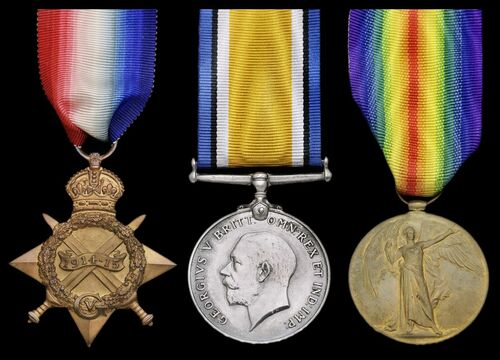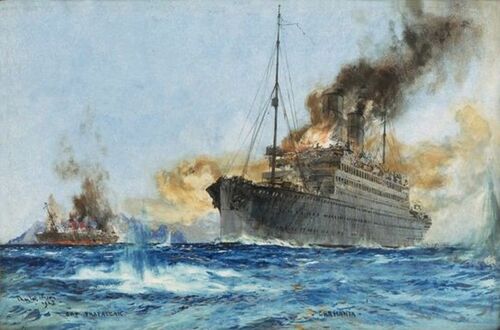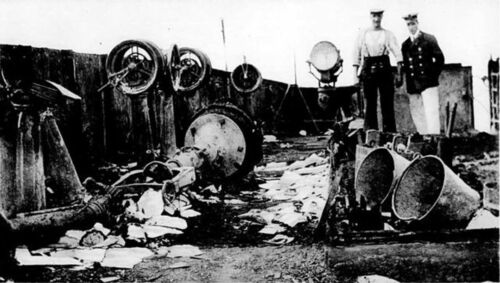Auction: 23001 - Orders, Decorations and Medals
Lot: 114
The Great War campaign group of three awarded to Corporal W. W. W. Cheshire, Royal Marines Light Infantry, who was present aboard the armed merchant cruiser H.M.S. Carmania during her famous duel with the German raider Cap Trafalgar in September 1914
It proved to be the war's longest 'single' naval engagement, one naval historian concluding, 'No single ship has been fought to the death in such an historic and Nelsonian fashion'
And the fierceness of the fight may be judged by the fact that the Carmania was hit by 79 projectiles and sustained casualties of nine killed and 26 wounded
1914-15 Star (PO 7466 A. Cpl. W. W. W. Cheshire, R.M.L.I.); British War and Victory Medals (PO. 7466 Cpl. W. W. W. Cheshire, R.M.L.I.), the last with officially re-impressed naming, good very fine (3)
Walter William Warner Cheshire was born at Sheflord in Bedfordshire on 8 September 1874 and entered the Royal Marines in May 1894. Having enjoyed a spate of seagoing appointments in the interim, he reverted to the Royal Fleet Reserve in April 1905.
Mobilised in July 1914, he joined the armed merchant cruiser H.M.S. Carmania and was consequently present at her epic engagement with the German raider Cap Trafalgar on 14 September 1914.
At the outbreak of hostilities in August 1914, the Cap Trafalgar was lying in the River Plate awaiting an opportunity to slip out and meet the German gunboat Eber. The liner was a well-suited ship for commerce-raiding and, on 1 September, somewhere off Bahia Blanca, she embarked from the gunboat a number of naval ratings and two 4.1-inch guns and six pom-poms. However, on the morning of 4 September 1914, off the western end of the island of Trinidad, she was surprised in the act of coaling by the British armed merchant cruiser Carmania, 19,524 tons, Captain N. Grant, R.N.
At first, she made off at high speed, but later turned about and prepared to engage. Both ships began firing at 7,500 yards, the 4.7-inch guns of the Carmania doing great damage to the hull of the enemy. The fire from the Cap Trafalgar was at first too high, but as the ships closed she began to score, setting the Carmania on fire under her bridge and cutting her main water pipe so that the fire could not be brought under control.
After an engagement lasting one hour and 40 minutes the Cap Trafalgar was heavily on fire and sinking. Towards the end of the action, she had attempted to escape but her engines were not equal to the strain and she finally capsized to port and sank by the head. Five boats crowded with survivors were picked up by the German colliers, the Carmania being still on fire and too badly mauled to render assistance.
Honours and Awards for the action comprised two C.B.s, one D.S.O., three D.S.C.s and 12 D.S.M.s; for further details see Deeds That Thrill The Empire.
Journey's end
Subsequent records refer to Cheshire as having transferred to the 2nd R.M. Battalion, Royal Naval Division and to him being on leave at the time of his death on 26 November 1915.
He was in fact a patient at the R.N.H. Haslar and died of disease. He left a widow, Hannah, to whom he had been married in the summer of 1907, and is buried in the Campton and Shefford Cemetery, Cheshire.
Subject to 20% VAT on Buyer’s Premium. For more information please view Terms and Conditions for Buyers.
Sold for
£140
Starting price
£70









